Soft roofs are laid all year round, since modern material is in demand on the market and has good technical characteristics. Installation of flexible shingles in winter is not always justified; it is better to postpone it until warm weather. However, there are certain temperatures at which a soft roof can be laid without compromising the quality of the resulting coating. The technology of work requires a special approach.
Features of work in the winter
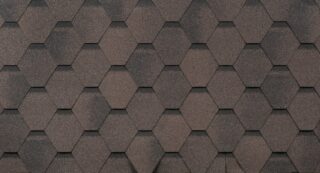
Working in cold weather increases the number of work steps required to install the roofing layer, while reducing the speed of shingles. The process may stop due to a sudden snowfall, a sharp drop in temperature to critical minus values.
Ways to provide the required working conditions:
- Installation of a safety awning. The construction site is covered with a protective awning from snow and rain. The structure is erected over the entire roof or placed on a certain plot of installation work.
- The use of heat guns. Temperature curtains and other climatic units are used in a similar way. As a result, they artificially provide the required microclimate with the required parameters.
Sometimes the installation of a soft coating is transferred to the spring months, and in winter they begin to make a roof structure from Mauerlat, rafters, and put a crate. The multilayer cake provides for insulation, waterproofing, vapor barrier, which postpone the installation of flexible tiles until the warm season.
The short time of natural light in winter is considered a difficult factor that hinders the proper organization of work. The problem is solved by installing powerful lighting devices for work after sunset. In severe frost, containers with roofing material are heated in a warm room for 1 - 2 days, then moved to the site.
Changing material properties in the cold
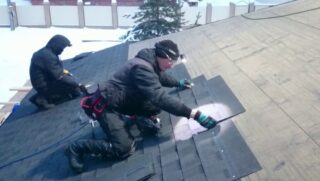
A flexible roof is a fiberglass canvas on which a polymer-bitumen layer is applied on both sides. The coating provides waterproofing, adhesion, heat and cold resistance.
Soft coatings are sensitive to both low and high temperatures. When heated above + 250 ° C, the layer begins to melt, and at -50 ° C, the coating hardens and breaks off in the form of crumbs. At negative values, plasticity decreases, polymerization slows down. Technologists have developed methods to neutralize this behavior under critical conditions by adding additives and additives.
The effect of cold on different types of soft surfaces:
- Oxidized bituminous shingles. During production, the molten resin is enriched with oxygen, which leads to an increase in the quality of the material. In general, shingles behave stably at temperatures above 0 ° C. Installation work at minus values reduces the service life due to increased fragility.
- SBS-modified (styrene, butadiene, styrene). Produced on the basis of artificial rubber, the addition of SBS (from 12%) strengthens structural bonds, increases flexibility, elasticity. The material is highly resistant to frost and high temperatures. At rates up to -30 ° C, the properties hardly change, the fragility remains within the normal range.
- APP modified (atactic polypropylene). The modifier in the form of a side residue in the production of isotactic propylene imparts high thermal stability to the bitumen mass. The material melts when it reaches + 80 ° - + 140 ° С, while the resistance to ultraviolet radiation increases.
For winter installation, SBS-modified types of bituminous tiles are used, which have protective properties against frost. Such materials are not cheap, since obtaining modified materials with improved characteristics is a complex process.
Possibility of laying soft roofs in winter
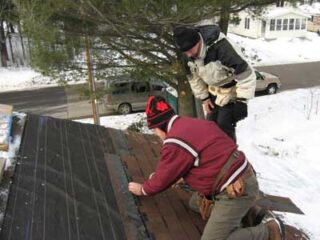
An important component that determines the possibility of installation in winter is the composition of bitumen. Impregnation is a natural compound of organic components. In its pure form, bitumen is not suitable for use in roofing, therefore, modern mastics are stabilized with chemical additives. As a result, raw materials for soft roofing are obtained.
Reasons for installation in winter:
- coating materials are cheaper due to lower demand during this period;
- an uninterrupted continuation of construction, which began in the fall, is required;
- specialist roofers are cutting prices for work.
Opponents of winter mounting argue:
- a significant increase in costs for the construction of protective greenhouses, additional heating, installation of lamps;
- too low temperatures for laying soft tiles in winter will still cause malfunctions, and heavy snow drifts can also affect.
During snowy periods, the rafters and the elements of the crate are saturated with moisture, therefore, these structural elements need to be additionally dried. This is especially important when installing insulation for a soft roof. For laying a flexible coating, the dryness of waterproofing, superdiffuse films is important. Installation of a soft coating is carried out only in dry conditions.
Temperature range for roofing work
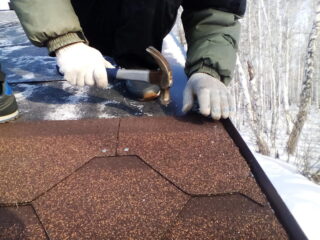
Chemical additives in modern varieties of soft tiles allow them not to deform at temperatures down to -50 ° C, and adhesives for fixing withstand indicators up to -35 ° C. The coating will not harden under such weather conditions, will not crumble.
Material manufacturers and construction technologists recommend carrying out work at temperatures above + 5 ° C, despite such a range of possible laying. Speaking of installation work, one should take into account not only the properties of materials, one must also take into account favorable conditions for a person.
Assessment of work conditions:
- favorable factors are determined by an acceptable temperature range, no showers, precipitation, low wind speed;
- unfavorable conditions arise when the temperature drops to critical indicators and below, heavy snow drifts, rains, when the wind increases over 15 m / s.
The economic component of construction plays a role. At + 5 ° C, the soft roof has plasticity, there is no need for softening with heating hair dryers, which reduces the cost of construction. Installation speed remains at the planned level without the use of coordinating processes.
In moderate snowfall, work is allowed, but not in heavy snowstorms. Protect from rain, if possible. Otherwise, you need to monitor the moisture content of structural elements and other roofing materials, not just shingles.
Installation at low temperatures
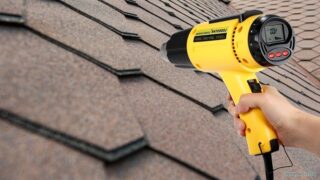
A step-by-step technology of work is mandatory, taking into account the complexity of weather and climatic conditions.
Features of work:
- preparation of the rafter structure, stuffing the lathing;
- waterproofing device, laying insulation;
- preliminary storage of materials (tiles, glue) in a heated room at a temperature not lower than + 20 ° C for a period of two days before use at the construction site;
- phased removal of materials to the installation site;
- local drying of each subsequent section of the roof before installing the tiles to increase adhesion;
- the use of a construction hair dryer in the process of gluing a flexible coating to the base of the roof;
- the action of direct fire is not recommended so that the material does not catch fire;
- heated elements of the crate are treated with special mastics to prevent freezing of the glue.
For winter installation, special fasteners are used - galvanized roofing hardware with a notch in the form of a ring. They are securely fixed in wood or other base materials, for example, OSB boards. In winter, flexible shingles are installed according to the scheme proposed by the manufacturer, without allowing independent changes in the laying technology.
Do-it-yourself soft roof repair in winter
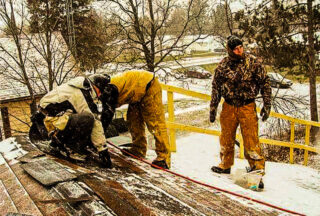
Preventive or routine repairs are classified as simple jobs. It is carried out with delamination in the area of seams, small breakthroughs, cracks in the coating. Such defects will be eliminated locally, without resorting to dismantling the entire layer. According to the standards, the current types include repairs of no more than 40% of the area of the total square of the roof.
Winter repair processes:
- clears the area of the leak from snow, ice;
- dry the area with a hairdryer or a gas burner;
- warm the patch material at room temperature;
- cut the patch to the size of the damage with a margin around the perimeter;
- glue or mastic is applied at the site of damage;
- heat the lower part of the piece with a hairdryer before using it on the roof;
- applied to the defective area, leveled, pressed with a roller.
It is important that there are no irregularities and bulging around the edges.
Major repairs are not done in winter, they carry out local repairs. Dismantling the layer, repairing the base, screeds are prescribed for more acceptable weather conditions.








